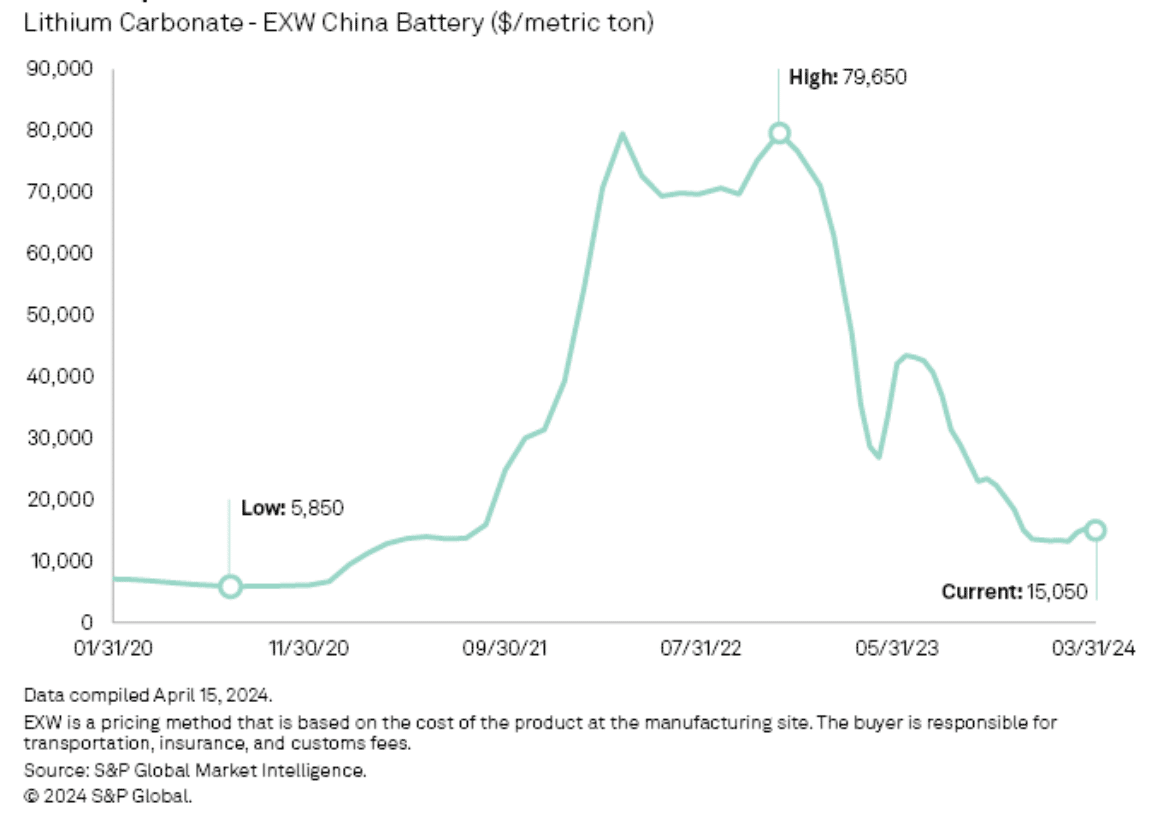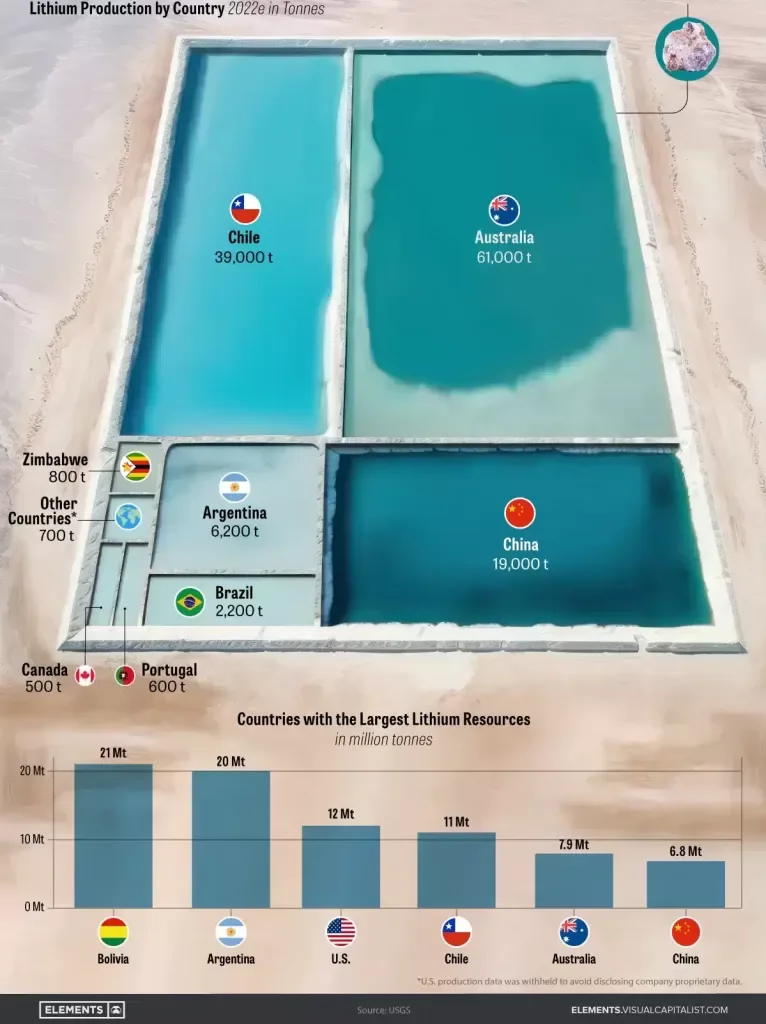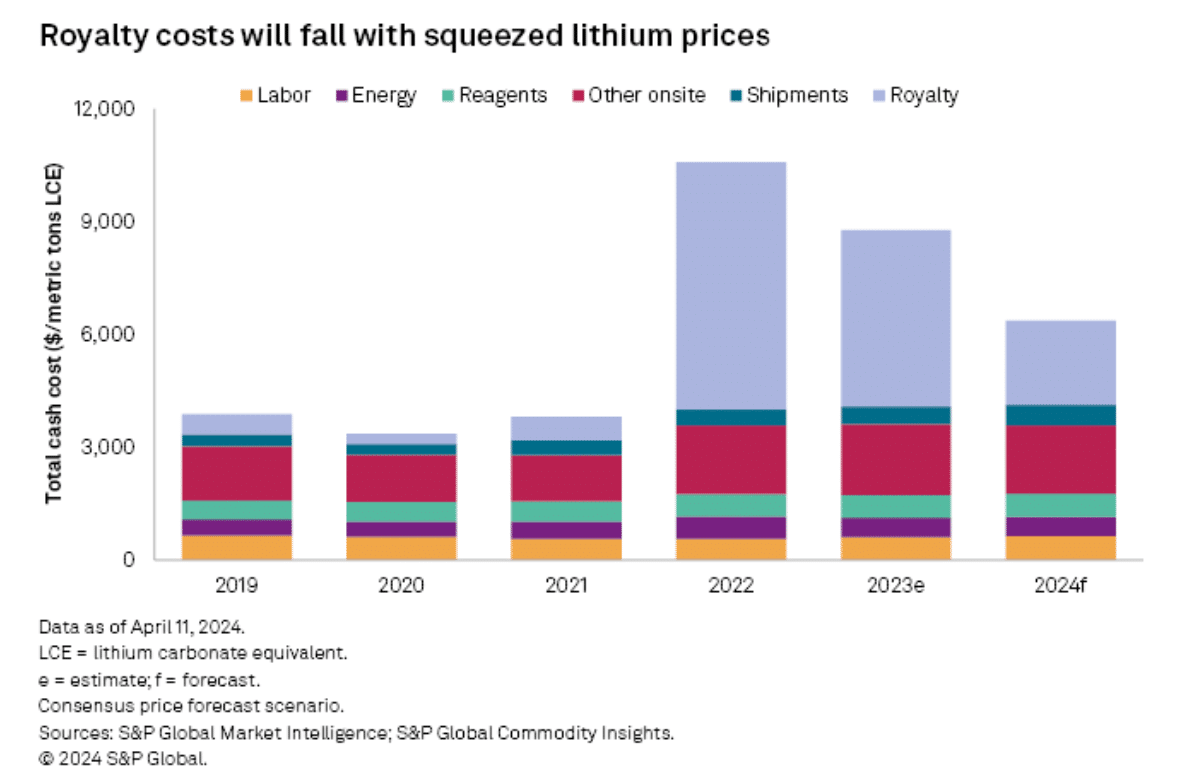Analysts anticipate that reducing royalty rates could provide much-needed relief for lithium producers grappling with plummeting prices. The decline in lithium prices since the beginning of 2023 has been significant, with battery-grade lithium carbonate prices dropping by over 80% by April 2023.
Amid this downturn, lower royalty obligations to local governments could help alleviate financial pressures on mining companies.
Lower royalty payments would directly reduce miners’ cost of sales, particularly as lithium prices decline, thus bolstering profitability amidst challenging market conditions. This adjustment is seen as a short-term measure to support miners until lithium prices stabilize or recover.
Lithium Challenges Amidst Price Decline
The financing landscape for lithium projects in the United States is also encountering hurdles amid sustained low lithium prices. This could impede the current administration’s efforts to strengthen the domestic battery supply chain.
Despite plans for around 100 lithium mine projects across the US, the appeal of these ventures has diminished due to the significant decline in lithium prices.


Data from S&P Global Market Intelligence reveals an 81.7% decrease in lithium prices from their peak in 2022. This prolonged period of low prices has made numerous projects less appealing to investors, affecting the overall viability of the development pipeline. As a result, financing for these projects is facing challenges, while impacting the domestic battery supply chain in the US.
Factors contributing to the current market dynamics include increased production capacity in 2023 alongside slower-than-expected growth in electric vehicle sales. These conditions have led to a scenario where lithium prices are expected to remain subdued until there’s a notable improvement in EV affordability.
Consequently, mining companies adjust their strategies. Some high-cost miners exit the market while others scale back expansion plans and focus on cost-saving initiatives.
The Royalty Realities in a Volatile Market
The fluctuation in lithium prices has a direct impact on royalty payments made by producers.
Royalties are payments made by a third party to the owner of a product or patent for the use of that product or patent. These payments are typically outlined in a licensing agreement, which specifies the terms and conditions under which the third party can use the product/patent.
The royalty rate, which determines the amount of the royalty payment, is calculated as a percentage based on various factors. These include the exclusivity of rights, the value of the technology or intellectual property, and the availability of alternative options.
Royalty structures for lithium extraction vary across major producing countries, with most employing variable systems that adjust with market prices.
In Argentina, royalties fluctuate by province but are capped at 3%. Meanwhile, Western Australia and Zimbabwe set theirs at 5%, with options for partial payment in minerals.
Chile, home to significant lithium reserves, implements a unique royalty system through its production development agency, CORFO. Operators like SQM and Albemarle, major players in the Salar de Atacama, face variable royalty rates ranging from 6.8% to 40%, linked to market prices. This approach aims to support miners during price fluctuations.
Despite Chile’s comparatively high royalty rates, investments in lithium projects there and in Argentina remain attractive. In fact, most projects in these countries maintain profitability even amid current price levels. Chile is the second largest lithium producer while Argentina takes the fourth spot.


As the lithium market evolves, variable royalty systems are gaining popularity for their adaptability to price volatility and support for the mining sector.
The Impact on Lithium Miners’ Bottom Line
In 2022, when lithium prices soared to historic highs, miners saw their royalty payments surge by a staggering 960.1% compared to the previous year. This increase in royalties significantly elevated overall miners’ production costs, with royalties accounting for over 60% of total cash costs.


While miners were able to absorb these additional costs during the peak price period, the likelihood of lithium prices returning to such levels in the near future is uncertain. As lithium prices normalize, royalty adjustments are expected to have a lesser impact on miners’ profitability. This is particularly prevalent in a market characterized by lower prices.
Lower royalty rates in a depressed price environment can provide miners with some relief. This will allow them to preserve margins despite challenging market conditions.
Market projections suggest a decrease in average royalty payments and total cash costs, providing a favorable outlook for lithium producers. More remarkably, investors still continue to show strong interest in lithium projects amid short-term price challenges, foreseeing their long-term potential.
As lithium prices continue to plummet, the call for reduced royalty rates emerges as a lifeline for struggling producers. With royalties comprising a significant portion of mining costs, lowering these obligations could inject much-needed stability into the industry.
- SEO Powered Content & PR Distribution. Get Amplified Today.
- PlatoData.Network Vertical Generative Ai. Empower Yourself. Access Here.
- PlatoAiStream. Web3 Intelligence. Knowledge Amplified. Access Here.
- PlatoESG. Carbon, CleanTech, Energy, Environment, Solar, Waste Management. Access Here.
- PlatoHealth. Biotech and Clinical Trials Intelligence. Access Here.
- Source: https://carboncredits.com/lower-royalty-rates-give-lithium-producers-a-lifeline/